 Computing: An Introduction, by Fred Gruenberger. Published 1969.
Computing: An Introduction, by Fred Gruenberger. Published 1969.20181001 TerraHertz http://everist.org NobLog home Updated: 20200823
A lot of people involved in the early wave of the personal computer revolution became very rich. I'm not one of them. My particular skill seemed to lie in almost catching that wave multiple times, but for various reasons always missing it. It was pretty frustrating at the time since I was generally aware of the potential and my not-quite making it, but lacked whatever (mostly initiative and confidence) might have made a difference.
Except for the first instance. That one I wasn't aware of till many years later. But I should still have seen it at the time, and these days wince every time I recall being so naive. We'll start with that, to get it out of the way so I can stop cringing in retrospective pain and shame as quickly as possible.
Electronic computing had been in development since before I was born, and was shifting from the era of vacuum tube machines, to transistor circuitry in the mid 1950s. I was born in 1955 and had been interested in electricity and electronics from a very early age, before I could read and write. When I was entering my teens in the late 1960s computing was a hot topic for anyone with an interest in technology. Which I certainly did have.
 Computing: An Introduction, by Fred Gruenberger. Published 1969.
Computing: An Introduction, by Fred Gruenberger. Published 1969.
I'd bought this book new when it appeared in stores here. It was my first encounter with the detailed principles of computing science and practice. I read it avidly.
In addition to the unique and beautiful cover, and clean layout style, the concepts it presented were fascinating to me.
Actually this is not my original copy. That one was later borrowed by a cousin, who never returned it. You know who you are. This replacement I bought many years later, after it became easy to search for and buy second hand books online.
My first exposure to actual computers and programming was was during my 2nd-last year of high school, in 1972. My maths teacher told the class of an opportunity in the coming holidays, where the Museum of Applied Arts & Sciences in the city (Sydney Australia) was offering a free computing intro workshop to high school students. They had a small IBM mainframe as a working museum display. I was the only student from my school who was interested and signed up.
It was really great fun. My first program ever was the archetypal Sieve of Eratosthenes prime number finder, but it worked. I think the language was PL1. The IBM had a vector graphics terminal (big round green-phosphor CRT screen) and I was fascinated to hear a description of how the code to display the picture worked.
There was a very smart and pretty girl my age also attending, who I'd enjoyed talking with during the course. Apparently the feeling was mutual since at the end of the course she presented me with her phone number. As an indication of how terminally socially inept I was, I was too stunned and awkward to offer mine in return (which probably hurt her feelings, sorry!) and I never had the courage to phone her. I wanted to but couldn't. I was an only child, introverted and chronically shy teenager.
That incident still makes me wince to think about, but isn't what this story is about. Oh, and you'd think that now in my 60s, after raising a family and being much more socially adept, such a silly case of 'frozen response' wouldn't reoccur. But no. Again.
My second computing exposure was in university, 2nd year Electrical Engineering. This was 1975, and there was no separate Faculty of Computer Science. I was high-distinction acing EE subjects, and when in my 2nd year they offered a computing subject I HD-aced that too. The university had just bought a large CDC Cyber-6000 mainframe, and at first for computing services that, via IBM punch card machines and presenting boxes of cards for batch processing, was it. It was lots of fun regardless. Unfortunately my enthusiasm for other required subjects such as Chemistry and Mathematics was very low, and along with a relationship breakup (first girlfriend, broken heart and all that), being extremely poor, and depressingly long commute times (train and bus both ways, hours each day), I dropped out towards the end of that year.
I started work in December 1975 as an electronics production service tech with a company (Delairco Bartrol) making equipment for the printing industry. That evolved into doing a lot of PCB layout artworks (tape and puppets method), and mechanical drafting. At this time there were no 'personal computers' at all, only mainframes and minis. I'd still never actually seen let alone touched an actual computer of any kind other than that one at the museum. Only read of them in magazines. I was reading about the newly introduced microcomputer chips produced by Intel and soon after by others, but hadn't had a chance to play with them yet. I could see their potential and was very eager to become involved.
At this time my boss at Delairco, a middle-aged Polish engineer who'd worked through the vacuum tubes and transistors eras, then more recently small scale digital logic circuits (7400 series), was given the task of designing a 'glass terminal' as a new product for our printing industry clients. A keyboard and CRT displaying a page of typed-in text, allowing editing before sending the text to an output device — typically still a paper tape punch. Up till then Delairco's products consisted of keyboards plus a small single line plasma display, that allowed typing and editing a short phrase before sending to paper punch tape. Which was then fed into typesetting machines.
Glass terminal? Well, that's an obvious job for a microprocessor, right? I showed my boss articles and brochures and data sheets for some of the available microprocessor chips. Whee, this would be fun, I'd get to try out this new wonderful thing. None of Delairco's existing products used micros, only hardwired logic. And in many cases only transistors.
Nope. He decided microprocessors were too risky, unproven, too complicated, and... basically was afraid to try. Instead he started doing a design using discrete TTL logic, with the screen character buffer held in MOS shift registers. Oh boy, cursor position, character insert and delete with a text page representation spinning in a dynamic shift register, what fun. He struggled and struggled with his design, while it seemed to me that was barely workable. And I certainly didn't want to be the grunt doing the PCB layouts for such an obsolete concept, if he ever progressed to the point where he thought it might work.
Even worse, by some quirk the company management had previously had a few fiberglass cases made for a future keyboard to paper tape product. Before doing any internal mechanical or electrical design, and somehow there were no drawings for the cases. Just the cases. Since I had technical drafting skills and some mechanical aptitude I got lumbered with the task of designing internal metalwork to fit them. I thought they looked grotesque and unsaleable. Not to mention that I knew the product would be another already obsolete no-micro mistake. My job satisfaction was going negative.
By then the early personal computer wave was well started in the USA. The Altair (publicised Jan 1975) and Imsai (late 1975) were being advertised in magazines like Popular Electronics and Byte. US magazines shipped to Australia by sea, and appeared on shelves here many months after their publish date. Also there was no way I knew of to buy these machines in Australia. No Internet, no Ebay, no way for an individual to order from overseas and have something shipped — in my experience anyway. This was driving me nuts with frustration!
Then in November 1977 Rudie and Lorna Hoess opened the first Computerland personal computer store in Australia. By chance, about 50 meters away from my workplace, just around the corner at 55 Clarence St, Sydney.
 |
 |
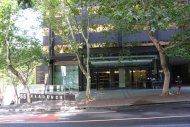 |
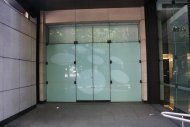 |
1. What the building exterior looked like back in 1977. (Pic from the web, that matches what I recall.)
The following pics are mine, taken today 20181226.
2. The exterior has had a makeover since, and now looks like this. Yeah typical. 'Darker.' What is this, a skyscraper in 'night mode'?
3, 4. The shop had a narrow street frontage. That blocky obstruction on the left wasn't there back then. It seems the space is unleased at the moment. Also the old Delairco building is completely gone.
I started hanging out at Computerland most lunch times. It didn't take long till they offered me a job as their first service and customer support technician. Of course I took it! Gave notice at Delairco and switched like a flash.
It was a huge relief to leave Delairco. Not only did I often have to work in the same room as my boss who was a heavy smoker, but also my other work area was on the 'factory floor', right next to where they made heavy industrial motor control panels. Large sheet metal cabinets, usually being hammered, power-saw cut or angle ground. Lots of extremely loud noise. There was no such thing as workplace occupational health and safety regulation in those days, and though after a while I'd started wearing ear protection I bought myself, by that time my hearing was already damaged. Which has remained a handicap my whole life.
Very soon after joining Computerland I bought my first computer (via the store), a Vector Graphic Vector-1 S100 kit chassis and minimal cards. It was a kit, I assembled it and it worked.
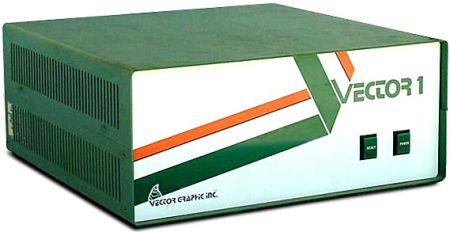 |
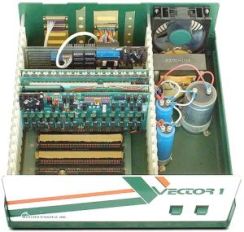 |
See Vector-1 for better pics, and also here.
I later sold mine.
But this was a problem due to needing more equipment, cards and software buys before it could do anything much. I didn't even have a serial terminal.
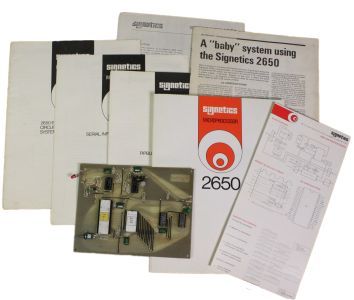 |
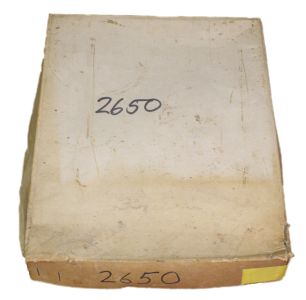 |
That was also a stumbling block with a small single board Signetics 2650 kit I'd bought, the 77up2, published in Electronics Australia in 1977.
It needs a serial terminal. I didn't have one then.
This is mine, I kept it. The box is pretty ratty, because 40 years old.
Reading Byte magazine I learned of Apple, who'd been selling their single board Apple I in the USA since April 1976. I didn't read of it till much later; late 1977, a while after joining Computerland. This was pre-internet Australia, sea freight took ages to get here, and despite Rudie Hoess' later reputation as 'the man who brought Apple to Australia', at that time he hadn't begun bringing in any Apple systems. It's possible he hadn't heard of Apple yet, or if he had he never mentioned it to his staff.
At this time I still had my Vector-1 S100 system, but with the chronic problem of not owning a serial terminal — which would cost more than the Vector-1 had! Being new to small computers myself this issue of needing a terminal (or rather the cost) hadn't occured to me until after I bought the Vector-1. Another option was to add a text display card to the machine, but that also had high costs and there were issues with finding software. The Apple I board greatly appealed to me since it included a video output and required only a TV for display and a simple, cheap keyboard. No expensive terminal required.
Staff at Computerland could buy products with a considerable discount. I asked Rudie if he could bring in an Apple I board for me. When he had an answer it was "OK, but there'll soon be a new version, the Apple II." He gave me some information he had on that, and pricing. (He wasn't being strictly accurate; the Apple II had been released by Apple in June 10, 1977 — before Computerland Sydney even existed. I didn't know that then, and he definitely left me with the impression the Apple II wasn't yet available. But he probably was just glossing over the shipping delays.)
Hmmm...
The Apple II certainly was a more capable machine, and I definitely wanted one. The issue was cost. I was on a tech's salary (not very much), and had recently moved out of my parent's home to a flat of my own in nearby Glebe. So of course, was suddenly exposed to all the costs of independent living. I didn't have a lot of spare cash.
My Vector-1 machine (assembled and working) could be easily sold though the store, helping me afford either the Apple I or Apple II. I'd have been able to buy at close to cost price (around US$500 for the Apple I, and US$1000 for the Apple II) but that was still a lot of money for very young me, in the 1970s.
If I'd stretched I could have bought an Apple I first, then the Apple II 'when it came out in a few months.' (Based on Rudie's comments on availability.) But that didn't seem a sensible thing to do. I decided it would be wiser, more frugal, better in the long run... to skip the Apple I and just wait for the II. After all it wasn't very long to wait.
|
 |
Then sold it to me on 15th Aug 1978, along with two Apple II prototyping boards. Since it was 'used' there was no sales tax applicable, which was nice for me.
So I bought the second Apple II Computerland in Australia ever sold; serial number A2S1 - 0480. It is such an early model that it has the hand-made urethane foam case, rather than the later injection molded plastic cases.
It occurs to me in hindsight, that it may have been my inquiry to Rudie about an Apple I, and his looking into availability, that prompted him to finally order and import a couple of Apple IIs. Perhaps the first brought into Australia. If so that adds another whole level of irony to this tale, since Rudie went on to make his fortune as an Apple distributor. The '480' serial number certainly demonstrates this was not one of the very first available.
The Apple II when I got it was great. I used this machine (and earned much of my income via it) for years, modified it quite a bit, and didn't think about the Apple I board any more.
Fast forward to 2010+. I read that Apple I boards are selling for extreme prices. It seems they are rare collector's items, much in demand. Only around 200 were ever made, and as usual with old technology, many people just landfilled them once they became obsolete. Now only around 70 are known to exist, and here's a list of them. They sell for up to US$900,000.
Sigh. If I'd bought one, I'd still have it. I still have the first single board microprocessor board I did buy, that 2650 thing, despite it being supremely useless apart from as a learning toy.
Oh, what a sinking feeling. Partly for being so dull; at that time I was fully aware the personal computer was a socially revolutionary event. And that Apple would go far. But did not think it through to realise the likely future collector value of very early machines.
FML.
 The PowerHouse Museum, Sydney, has an Apple I in its collection.
The PowerHouse Museum, Sydney, has an Apple I in its collection.
Cite: Apple I computer 2016, Museum of Applied Arts & Sciences, accessed 30 Saturday, 30 September 2017 2:11:20 PM 2017, <https://ma.as/397247>
They state:
"This particular Apple one was originally owned by the local technology pioneer, Rudie Hoess. In the mid 1970s Rudie established the Computer land reseller franchise and introduced the Apple II to the Australian market where it was embraced by home users and the education sector."
Personally I strongly doubt Rudie himself put together or ever used this system. I never saw him actually use any of the machines he imported through Computerland. Never saw an Apple I at the store, and in the early days I was the guy who tested everything before it went to customers.
Rudie was an 'ideas man', a wheeler-dealer business man, friendly, jovial and pleasant to work for. Quite often he'd invite the entire staff out to dinner. But he didn't seem to be interested in using the machines himself. It's more likely he acquired this Apple I sometime later, as a curio. And then eventually gave it away, ha ha. Bet he's kicking himself as much as I am. Well, karma for talking me out of buying one.
Also he was not handy with tools. For example, this incident from Computerland days:
The shop was at street level, with a plate glass frontage. The large doors were also plate glass with no frame, just hinges, lock and handle attached directly to the thick tempered glass. One day Rudie wanted to put a powered advertising sign outside on the sidewalk. The only way to power it was by running a cord out from inside the shop, and the only route was via the door. But the gaps around the glass were not large enough for the cord.
That day I was in the repair workshop room at the back of the store. This is what I heard: "bang. bang. bang. BANG. *BANG* !!BANG!! !!!BA-KWWSSSHHHHHHHhhh..."
Running out to the front, there was a red-faced Rudie standing by a mound of tiny glass pieces where the shop front door had stood. He'd been attempting to chip a bottom corner off the tempered glass door, using a hammer and a screwdriver as a chisel. He apparently didn't know that with tempered glass the entire sheet explodes into tiny pieces if the surface is fractured anywhere.
Heh. He was the boss, no one said anything. If Lorna had any comments, only Rudie heard them. But for a while everyone tended to break out in giggles randomly.
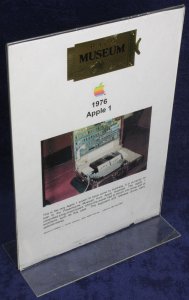
|
I've been working with the Australian Computer Museum Society for a while now. Among a collection donated by Max Burnett, I recently came across this. (Click it)
It's a display sign, originally from Max's personal computer museum. Which mentions that the Apple I on display at the Powerhouse Museum, is the only one known to have come to Australia.
Sigh. Well there would have been two, if I wasn't stupid.
When the Apple II first came out in June 1977, the only means for saving and loading programs was via audio cassette tape. There were audio in & out jacks on the rear, and software in the ROMs to allow data in memory to be output as a simple edge-encoded format in the audio range. You pressed Record on the cassette machine, then hit enter on the command to dump a memory range or a Basic program. Reading it back in was a similar process, slow and not 100% reliable.
Among early home computers at that time the S100 family had floppy disk drives (8" and 5.25" size floppies) available, but they were complicated and quite expensive.
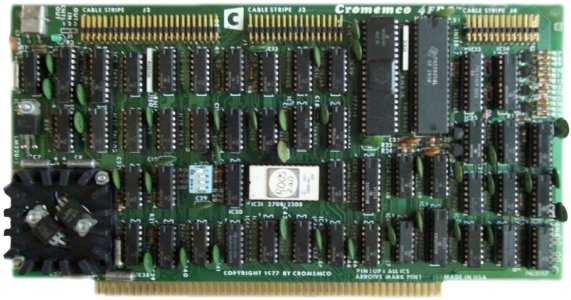
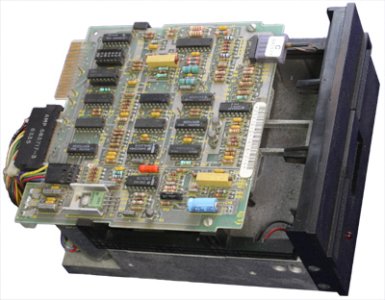
Above are a Cromemco 4FDC floppy disk controller card for S100 systems, and a Shugart 400L 5¼" floppy disk drive. There would be a 34 wire ribbon cable between them, plus a power cable to the drive with +12V and +5V (4 wires.) This was a very typical configuration; similar for 8" floppy disk drives.
When Apple came out with their own floppy disk system for the Apple II, at that time it was amazing. Being a tech at Computerland I got to see the insides immediately. Apple had used a standard Shugart 5.25" drive chassis, but instead of the very complicated PCB in Shugart drives, and the equally complicated interface cards for S100 machines, Apple's had comparatively almost nothing. Astonishingly few parts, which made them relatively cheap.
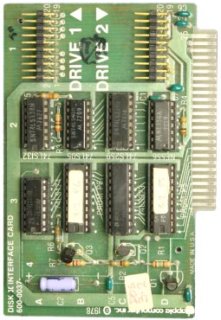 |
 |
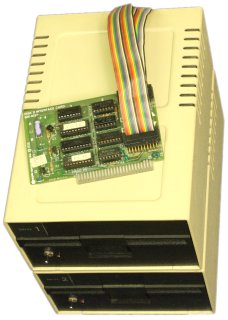 |
Click on controller and drive pics at left for closups of the PCBs.
Note there was no separate power cable to the drives. Nothing but the ribbon cable.
The toggle switches on the front of the drives are my mods. They are in series with the 'write protect notch' microswitch.
The first widely released Apple II DOS was version 3.1, released in July 1978. I bought a two drive set as soon as they arrived in Oz, and was surprised to not receive a manual. Rudi told me none were available, which I found hard to believe but what could I do?
Next year in February 1979 Apple released an update to DOS 3.2 and this time there was a manual, which included schematics of the drive and controler card.
Some sources on the net claim that a manual was available from the first release of Apple DOS, but others get it right — from July 1978 (Ver 3.1) until Ver 3.2 in Feb 1979 (plus shipping delays to Australia), there was no manual for Apple DOS. The Ver 3.2 manual includes schematics for the hardware, but for that first period there were no schematics either. Don't forget there was no Internet then.
Well, not knowing how it managed to work with such minimal circuitry was unbearable for me. So I reverse engineered the circuits, including extracting the binary code from the small ROMs. I found their operation was heavily software dependent, with the Apple II's 6502 CPU doing much of the work of decoding the data stream from the read heads, controlling the stepper motor, and so on. I was in awe of how cleverly it was designed.
Not satisfied until I understood all of it, I started work on disassembling the Apple DOS (Disk Operating System.) I had already written myself a simple disassembly listing print utility, and patched a commercial Assembler to include all the available 6502 addressing modes and several other essential Assembler features that it had been lacking.
What I found was quite interesting. One of the weak points of Apple DOS was the relatively low data storage capacity of the floppies. It was only 113.75 KB per disk side compared to considerably higher (360 KB then) with standard Shugart 5¼" drives and their controllers. It turned out the low density on the Apple drives was mostly due to timing limitations in the 6502 assembler code that handled the stream of data from the read bit-decoding state machine. The code, as written, simply could not go any faster.
But, but, but... I could see they hadn't done it optimally. The lowest level read code consisted of a series of nested loops, and handling all the loop indexes was taking a lot of time. So I 'unrolled' the loops; writing a block of very linear code that did the same thing. It was easy to patch this into an image of Apple DOS and try it.
It worked! And being faster, it allowed a very worthwhile increase of data density on the floppy. I adjusted my patched copy of DOS so it worked perfectly, at the higher density.
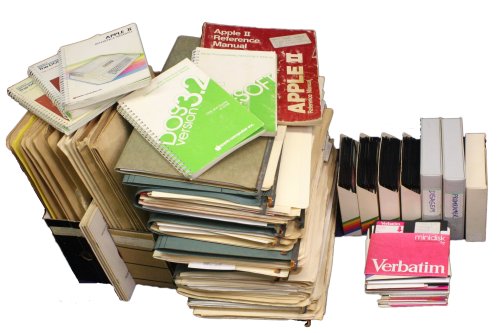 The story, schematics and listings of those efforts have their own page: Patching Apple DOS 3.2. (%%% not yet written)
The story, schematics and listings of those efforts have their own page: Patching Apple DOS 3.2. (%%% not yet written)
Pic at left is most of my documentation from many projects involving the Apple II over the years. Dug out for reference in these articles. Only a few folders and floppies in that pile relate to the Apple DOS patch. There's also a fair pile of related hardware relics in boxes.
It was in the original plan for NobLog to include a chronology of all my early software and hardware work. But of course so far I didn't get to that. Now that I have all this Apple II stuff accessible again, maybe I'll pull my finger out. (%%% not yet written)
My old Apple II and the RGB monitor I used with it, haven't been turned on since sometime in the 1990s. For these articles I'm hoping to get them going again, and crossing my fingers in hope the old floppies are still readable. So I can (finally) work out how to archive my Apple code to PC-based storage. For sentimental reasons. And so...
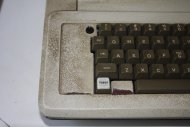 |
 |
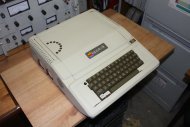 |
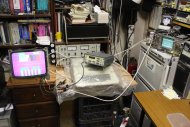 |
1, 2. The old machine was horribly dirty from years of use long ago. Looks quite sad. Here starting to clean it.
3. Cleaned, on the outside anyway. The inside still needs work. I shudder to think of the flakey old IC sockets and other hard faults and intermittents still to deal with in getting this going again. Plus the internals are heavily modified: see Hacked Apple II.
4. At least the old monitor still works. Here trying it with a test pattern generator. Frustratingly, the one thing I can't find is the video cable between the monitor and the Apple. That monitor is an RGB model from early arcade games (another episode in my 20's working career) and I had built it into a wooden case (removed for this power-up test.) The video connector is a D9, so the cable was one I'd made. If I really can't find the original I'll just make another.
So where was the fail? This:
Back in late 1978 when I did the DOS patch to achieve greater floppy capacity, I was a shy service tech, single and with near zero social confidence. Busy with working and living life on not a lot of money, and feeling fairly depressed about having met a nice girl I liked very much, but who already had a boyfriend (who was much more socially accomplished than me, so I had no chance.) The idea of actually contacting Apple and asking if they might be interested in an improved capacity version of their DOS simply didn't occur to me. Idiot!
There were always customers in the shop, and I'd often talk with them. One guy who came in regularly happened to hear of my patched Apple DOS. He was very interested, and asked if he could have a copy of the code. I was chuffed, and happily gave it all to him. After which he ceased turning up in the store. I can't recall how I heard, but I did find out that he'd gone overseas to the US.
Years later I'd heard that Apple was having something of a financial crisis at this time. The relatively small capacity of their floppies was turning out to be a serious sales dampener.
Around a year after my DOS density patch was working, Apple came out with an improved DOS, version 3.3. The major difference was a greater data density, and curiously by about the same amount as my version. That hit the right market spot, and Apple sales took off. Never to look back.
Even at the time, considering what had perhaps happened was pretty depressing. I couldn't even bring myself to disassemble the new DOS version, because I was afraid I'd find signs of my own code in it. Looking back, realizing there's a chance my giveaway possibly made the difference between Apple failing, and what they later became, is very painful. I prefer to think Apple just figured out the better way themselves, and it was nothing to do with that guy and his copy of my patches. The fact that I strongly dislike the 'elitist, stupidly expensive, planned obsolescence, closed-hardware computing' cancer Apple later became, how the company was ruined by an arsehole ex-CocaCola CEO, and learning of how Jobs ripped off and backstabbed Wozniak, who was my tech-hero, doesn't help.
As a final irony, I live in Sydney Australia, and I hear Steve Wozniak moved to Australia in 2016 and is working in Sydney. I'd love to meet him, though am afraid I'd burst into tears if I did. So much sadness in my Apple II and Mac memories. My own efforts that fell so far short of greatness, and then seeing Apple gradually morph into something horrible, and the long pain of being forced to migrate to MS-Intel with their ghastly software and hardware architectures and even more vile corporate agenda. It's like a great love, that gradually turned into an inescapable nightmare. (Another painful circumstance I know intimately, but that's another story...)
| Dec. 8, 1975 | Paul Terrell opens The Byte Shop in Mountain View, California. One of the world's first computer stores and the first to sell an Apple computer. Ref: https://www.cultofmac.com/457420/byte-shop-opens-tiah/ |
| April 1, 1976 | Apple Computer founded by Steve Jobs and Steve Wozniak. Ref: https://en.wikipedia.org/wiki/History_of_Apple_Inc. https://en.wikipedia.org/wiki/Paul_Terrell |
| July 1976 | Wozniac demonstrates his first hand-built Apple I prototype at the Homebrew Computer Club in Palo Alto, California. Ref: https://en.wikipedia.org/wiki/Apple_I |
| ? 1976 | Apple delivers the first 50 Apple I assembled boards to The Byte Shop. Apple were paid $500 per board; Terrell's store price was $666.66. |
| April 16, 1977 | Debut of the Apple II. Presented at First West Coast Faire by Steve Jobs and Steve Wozniak. Price: $1295 (Debut also of the Commodore PET, presented by Chuck Peddle, and the Radio Shack TRS-80.) Ref: https://en.wikipedia.org/wiki/West_Coast_Computer_Faire http://www.computerhistory.org/tdih/april/15/ |
| May 10, 1977 | The first motherboard-only Apple II computers shipped. Ref: https://apple2history.org/history/ah04/ |
| June 10, 1977 | Apple began shipping the full Apple II. Ref: https://en.wikipedia.org/wiki/Apple_II http://oldcomputers.net/appleii.html |
| Sep 30, 1977 | Apple discontinues production of the Apple I. Ref: https://en.wikipedia.org/wiki/Apple_I |
| Nov ? 1977 | Rudie and Lorna Hoess open Computerland in Sydney. The first personal computer store in Australia. |
| ? | Shortly after they open I join Computerland Sydney as tech support. |
| ? | From reading Byte magazine I learn of the Apple I and decide to buy one. Asked Rudie if he can import one, but he tells me the Apple II 'will be available soon', talks me out of buying an Apple I. (Maybe they already were no longer available anyway.) Plan changes to getting an Apple II. |
| January 1978 | Red Book. Apple prints a red-cover edition of the bundle of notes they'd been including with early Apple II sales. It has no Apple part number. Online: http://a2central.com/1494/apple-reference-manual-january-1978-red-book-v2-project/ Ref: https://apple2history.org/history/ah04/ |
| April 10 1978 | Apple signs a $13,000 contract with Shepardson Microsystems to write a DOS and deliver it within 35 days. Ref: http://www.digibarn.com/collections/business-docs/apple-II-DOS/DigiBarn-ShepApple2DOS-06A.jpg |
| June 29 1978 | DOS 3.0. Was this publically released at all? Consensus says not. Maybe a limited release? Ref: https://apple2history.org/history/ah14/#10 Beneath Apple DOS. Don Worth and Pieter Lechner. Page 2-1. |
| Apple DOS ver 3.1 public release, hardware and software. But without a user manual. | |
| June 1978 July 20 1978 | According to https://en.wikipedia.org/wiki/Apple_DOS, or According to https://apple2history.org/history/ah14/#10 and Beneath Apple DOS |
| DOS 3.1 tracks have 13 sectors, each holding 256 bytes. Single-sided, with 35 tracks, gives a total data capacity of 116,480 bytes, or 113.75 KB. Around 10 KB of this is occupied by DOS and directory, leaving only 100 KB free for the user. | |
| Aug 15th 1978 | The first two Apple II imported by Computerland arrived shortly before this, with one used as a store demo for a couple of weeks before I could buy it on the 15th: Apple II SN A2S1 - 0480. It came with the Red Book. It was something of a battle to prevent 'my red book' being randomly sold at the store, which is why it has "NOT FOR SALE" written in large black felt pen on the cover. There was no sign nor word of Apple DOS floppy drives yet. So for some months I was using the cassette tape storage system. |
| ? | As soon as Apple DOS floppy disk drives arrive at Computerland, I buy 2 drives, a control card, and the software. What, no manual!? |
| ? 1979 | New 'Apple II Reference Manual' released, replacing the 'red book'. Product # A2L0001A (030-0004-011) |
| Feb 16 1979 | Apple releases DOS 3.2 Ref: https://apple2history.org/history/ah14/#10 This time there was a manual, including schematics of the drive and controler card. But I didn't hear of it. Took a while to get to Australia. |
| May 1979 | I reverse engineer the Apple floppy system schematics. (Dates 19790508 to 19790511 from my hand drawn schematics.) |
| ? | At some point I get DOS 3.2 and the manual with schematics. The usual snail-paced shipping delay. |
| ? | Working with Apple DOS 3.2 code, I disassemble enough to figure out how it works, see a way to improve the density with purely software changes, and implement it. |
| ? | I chatted with a Computerland customer about my improved Apple DOS. He asks to borrow my source code and documentation, which I provided. He returns them then leaves for the USA, I never heard from him again. |
| July 31 1979 | DOS 3.2.1 released. Minor improvements. I don't recall if I ever received this. Ref: Beneath Apple DOS. Don Worth and Pieter Lechner. Page 2-2. https://apple2history.org/history/ah14/#09 |
| August 25 1980 | Apple releases DOS ver 3.3. Ref: Beneath Apple DOS. Don Worth and Pieter Lechner. Page 2-3. https://apple2history.org/history/ah14/#10 Ver 3.3 used 16 sectors (4 KB) per track rather than 13. Total capacity became 143,360 bytes (140KB), up from 113.75 KB. 16 KB used by DOS, leaving 124 KB free for the user. According to online commentary the updated P5A/P6A PROMs in the disk controller allowed this capacity increase. |
| ? | I get the Ver 3.3 upgrade and new PROMs. Now I have a separate controller card with the 3.3 PROMS, but I recall that at the time I mostly stuck with 3.2, to avoid Muffin-converting all my floppies. |
| 1980 onwards. | Apple DOS coasted, with no further significant advances. Apple focussed on other products (Apple III and SOS operating system) then abandoned them. Later, in early and mid 1983 two minor Apple DOS revisions were released (both still called DOS 3.3) for bug fixes and to support the new Apple IIe. |
(Question mark dates are due to my not keeping a diary, and mostly not dating what documentation I did produce.)
So, I designed an Apple II plugin board that did all that. PROMs, RAM and programmer, hence Promramer. It's a cheesy name, I know. But I was in my early 20's and there was no Internet, what can I say?

The initial development of this card began in 1980 and wasn't well documented. I still have a hand-drawn schematic and IC layout for the prototype. It's in a folder marked "Ver 1 handwired", and has the yellow highlighting that tells me I was wiring a protoboard from it, but I can't find that board and don't even recall doing it. Irritatingly there's not a single date written on anything in that folder including all the hand-written assembler code — a very slack habit I had then. Six pages of schematic, in very faint pencil (too faint to scan), with no dates or page numbers and very few comments. I probably hadn't even given this project a name at that point.
The next schematic is dated 24th Jan 1981, has the Promramer name and notes "Revision zero (only two PCBs made)". More highlighting (as with keeping track of traces when laying out a PCB) and lots of alterations in red pen. At this time I was still learning the requirements of the Apple II peripheral bus. The PCB layout was done using black stick-on tapes on three clear film sheets — two sides and a solder mask. Later versions used this same artwork, but with changes made by pulling up some tapes and pads and sticking down new ones. This was how it was done then. Too much work and expense was invested in the original layout sheets, to just put them aside and redo from scratch for a new version.
By May 1982 I had a debugged PCB design and code. I ordered 10 'Rev A' PCBs made on 11th May 1982. The first Promramer sales receipt I can find was on June 8th 1982. By July I'd assembled and sold almost all those first 10 boards, so on July 8 ordered another 50 PCBs.
I was hand assembling a few at a time, but had done assembly sequence instructions and test software, both for my own use and in anticipation of organizing higher volume production. The manual was finished (including the circuit diagram) and I hand-cut and glued reasonably professional looking plain-box packaging, complete with formed styrofoam carrier. The packing design was documented, but still lacked print artwork. I was providing blank cartons but knew the next step was to get a professional printed package design done.
 |
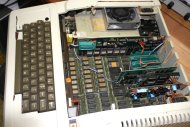 |
 |
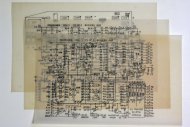 |
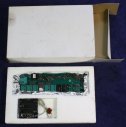 |
1. A page of the early Revision Zero schematic, dated 24/1/81. Or at least the original was, before being photocopied then marked up in coloured pen with mods. And the original seems to be lost. Sigh. I hate how slack I was then.
2. A card installed. (No batteries in the holder.) This is 'my one', which is actually the sole 'Rev zero' card PCB that I'd assembled, then added mods as needed. All the EPROM sockets are full, with various utilities I'd written.
3. Bare 'Rev A' PCB rear (top) and component side (bottom.) That long narrow form factor was a pain for layout, causing a near insurmountable signals traffic jam around the middle.
4. The schematics for Rev A. Hand drafted on drawing velum. Which has gone yellow with age. These were for inclusion in the user manual. (Downloadable below.)
5. A card and backup power module in the styro packing. The cardboard box here is one of the originals that I hand made. But it's been knocked around a bit in the 36 years since it was glued together.
 |
The manual was produced on my Apple II (I forget which editor) and printed on a dot matrix printer. Above is the first draft, proofread by a friend.
At left is the downloadable full manual including schematics. It's 4.6 MB. Right-click and 'save linked content as'. (Not just the small 24 KB link image.)
Of course the original manuals I supplied were photocopies. This digital version was produced now in 2018, by scanning the surviving paper master copy.
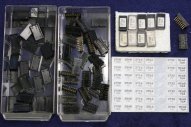 |
 |
 |
 |
 |
 |
 |
1, 2. EPROM type selection was via a 16 pin jumper block. Modern device programmers use identical universal pin driver circuits for all pins of the socket, so don't need crudeness like swapping jumper blocks for different devices. But with early 1980s tech, there wasn't room on the Apple card profile for anything fancy.
3. The battery power module for the CMOS RAM was optional. It contains all the circuitry for power rail level detection, and lockout of writes to the CMOS RAM if power is below safe operating level.
4. Since the battery module circuit is simple, I etched and drilled the small circuit boards myself. Here's the original art made with stick-on puppets, and a panel of film I step-exposed, so I could etch many boards at once.
5. The loose single PCB is a drill template. It clips onto the larger PCB panel to guide hand drilling of one board at a time. Hey, it worked and cost virtually nothing.
6. The battery holders were a common item. I just ripped out the springs at one end, and fitted the small PCB in the empty battery slot.
7. Schematic of the battery power module. Hmm, it seems I never drew up a neat copy for the manual. Tsk. And I also now notice that though there is a hand written parts list with component values in the folders, it's not in the manual. My first product, and I missed some things, I guess.
But before CAD, PCB layouts were done manually with stick-down tapes on clear film. In this medium 'moving things around' is highly undesirable, due to costs in time, materials and exasperation. So how were layouts planned? Especially with a tight board, there had to be some way to get an idea of what would work, before sticking down tapes (that cost non-trivial money, btw.)
Here's how. Working at some magnified scale (usually 4x), on translucent paper over a precision grid film (those really cost too!) the rough layout was drawn by hand in pencil. If you needed to redo a significant area, you'd trace it onto another sheet before erasing that area. So you had a record of what you were altering. Keeping tabs on all the circuit nets and component nodes, those which were on the PCB already and those which remained to be done, was also a pencil and paper chore. It all had to be done with fanatical care, or else you'd produce a PCB (at great cost) with errors. And have to go through the whole cycle and board production costs again.
Thankfully, for most of my electronics career after those first few years I had CAD software tools. So never again suffered through the pain of manual layouts and endless hours sticking tapes and pads down, fine surgery of joins and edges with a scalpel, and peering through a thing like a jeweler's lupe but with precision optical scales. Then sometimes having to rip up hours of work and do it again.
 |
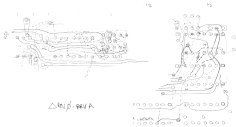 |
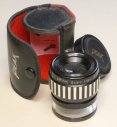 |
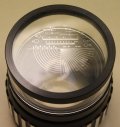 |
1. The pencil PCB layout for Rev zero of the Promramer. The linked image is 2700 x 900 px, 540KB, to give the full visual effect.
2. Pencil layouts of two areas that changed for Rev A.
3, 4. My old lupe for circuit board layouts. Where tiny dimensions matter, and so there has to be a way to measure them.
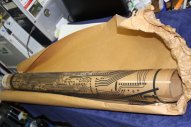 |
 |
 |
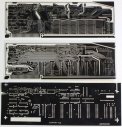 |
 |
 |
1, 2. Sigh. The Promramer PCB artwork I did in 1981-2, used stick-on tape and puppets from Bishop Graphics for pads and tracks. This was still the only affordable way to do it back then. There are three films; one for each side and a third for the solder mask overlay (same both sides.) As expected when I dug out the original PCB films today and partially unrolled them, a lot of the pads and tracks have had gum-failure, and simply fell off.
3. The artwork is dead. It is a non-layout. Shuffled off its mortal donuts. Pining for the fjords.
4. Not that there's any chance I'd need to reproduce the PCB, but at least I could because I have these 1:1 sized film prints from the PCB manufacturer. (Printronix.)
5, 6. Not related to the Promramer, just another small PCB I did earlier for some customer of Computerland. Called "APCR" it was an interface between a reader for IBM punched cards and an Apple II. Worked fine. Included here as an example of a different PCB layout technique, using red and blue tapes on a single mylar grid sheet. Blue is the front (component side) and red is the back. They are photographically transferred to the PCB with red/blue filters. This one is dead too, due to tape glue failure. Many track segments can be seen to have shifted or come loose. The paper sheet is the drill drawing, specifying mechanical details including drilled hole diameters.
It's a bit ironic being reminded of that APCR project, given my current punch card reader restoration project.
 |
 |
 |
 |
 |
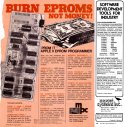 |
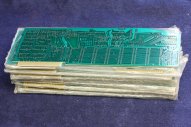 |
1. A Promramer Rev-B board development to take a 28 pin socket, handling more EPROM types and the Intel 8748/49. It was a work in progress in 1986, though it wasn't clear how I would fit all the extra circuitry into the Apple II extension card outline. It was tight enough just for the original Promramer.
2. It's a strange feeling to see the net result from several years of effort, in such a small space. Of course there were many other projects and jobs in that time, but still...
3, 4, 5. My first 'Orders Book', with the pages for purchase of the first 10 'Rev A' PCBs on 11th May 1982, then another 50 on 8th July 1982.
6. A couple of adverts from the April 1982 issue of Byte magazine. There were other EPROM programmer cards available for the Apple II, but that's all they were. See the prices? I was selling the Promramer for $270 after the first few, and would have gone lower if having them mass produced. For a far more capable board.
7. So why do I still have 35 bare Rev A boards (out of 60 made), never assembled and sold? See below, for this story of Fail.
Really, it was a very good product. Being able to program EPROMs and plug them into the ROM banks and have your own code run directly on startup of the Apple II, was tremendously useful. It also had another feature that vastly improved the convenience of routine tasks with the Apple II.
The EPROM programmer firmware, in an EPROM in one of the six sockets, included startup code that scanned the other sockets for EPROM headers detailing utilities in those EPROMs, then presented the list in an interactive screen menu. The Apple II didn't support multitasking, but this utility provided a convenient way to switch between applications. Long before the Windows Task Bar.
They sold pretty well, despite a pathetic total lack of advertising and thus very small market exposure. People who bought them liked them a lot, and I only ever had one come back for repair. (I'd included a schematic and theory of operation in the manual, of course. Even then I believed in Open Hardware, though the principle didn't yet have a name.)
But alas I made a novice fatal mistake. Another one of the Computerland techs, a guy I considered a friend, had left Computerland and opened his own computer store in northern Sydney. That impressed me, so when he offered to market the board for me I thought that could only be good. And so agreed to his demand for an exclusive distributorship of the Promramer, in return for his marketting efforts.
Sigh. He turned out to be completely incompetent at marketting. Essentially did nothing. No Australian or international advertising at all. At a time when the Apple II was selling hugely worldwide, and there were no competing cards anywhere close to mine. I was selling them at a better rate myself, before he entered the picture. I was getting some international sales just from word of mouth, but not enough to really live on, and certainly not enough to get rich from or fund time put into development of further versions and code for new EPROM types as they appeared. Worse, I was too shy and kind-hearted (read 'gutless') to tell him to take a hike and cancel that agreement for non-performance. Even knowing nothing about marketting, I could have done far better myself — if I'd felt free to try. It's probably fair to say that his inaction killed this product.
The most galling thing now is, that I can't find any written form of that 'contract', and have a strong suspicion there wasn't any, and it was just a verbal agreement. Which makes me doubly an idiot. I could have just ignored it, but felt bound by friendship and my word.
Between 1977 and end of production in 1993, around five to six million Apple II series computers had been produced. I never came across any plugin for the Apple that competed with my Promramer. I should have been selling tens or maybe hundreds of thousands of them. (Or at least some later variants with a wider range of EPROMs.)
This one left me really bitter. Such a lot of work sunk into it, so much potential missed, so much personal fail.